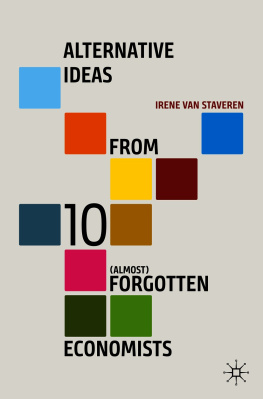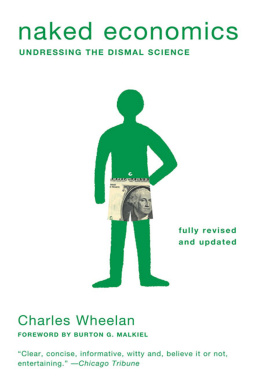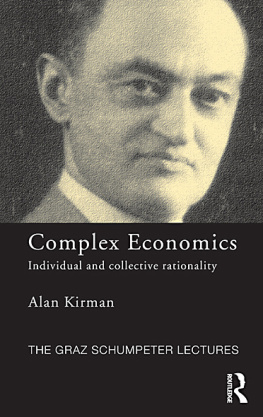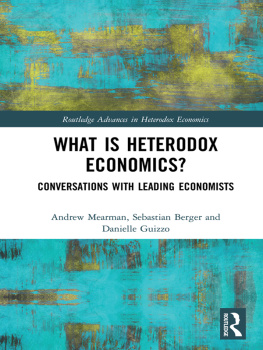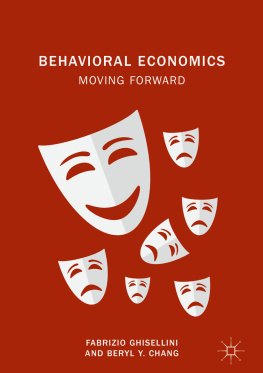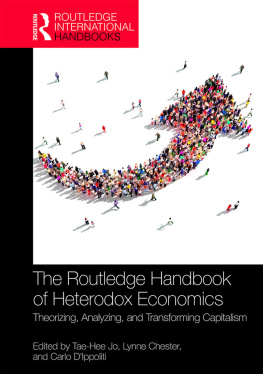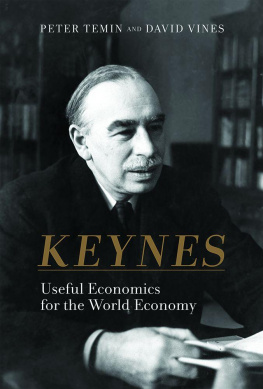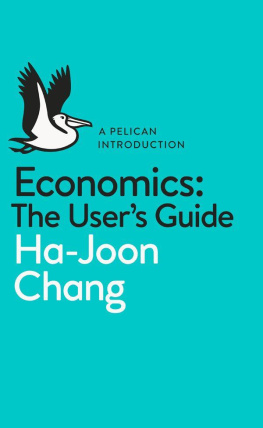Irene van Staveren - Economics After the Crisis: An Introduction to Economics from a Pluralist and Global Perspective
Here you can read online Irene van Staveren - Economics After the Crisis: An Introduction to Economics from a Pluralist and Global Perspective full text of the book (entire story) in english for free. Download pdf and epub, get meaning, cover and reviews about this ebook. year: 2014, publisher: Routledge, genre: Science. Description of the work, (preface) as well as reviews are available. Best literature library LitArk.com created for fans of good reading and offers a wide selection of genres:
Romance novel
Science fiction
Adventure
Detective
Science
History
Home and family
Prose
Art
Politics
Computer
Non-fiction
Religion
Business
Children
Humor
Choose a favorite category and find really read worthwhile books. Enjoy immersion in the world of imagination, feel the emotions of the characters or learn something new for yourself, make an fascinating discovery.

- Book:Economics After the Crisis: An Introduction to Economics from a Pluralist and Global Perspective
- Author:
- Publisher:Routledge
- Genre:
- Year:2014
- Rating:3 / 5
- Favourites:Add to favourites
- Your mark:
- 60
- 1
- 2
- 3
- 4
- 5
Economics After the Crisis: An Introduction to Economics from a Pluralist and Global Perspective: summary, description and annotation
We offer to read an annotation, description, summary or preface (depends on what the author of the book "Economics After the Crisis: An Introduction to Economics from a Pluralist and Global Perspective" wrote himself). If you haven't found the necessary information about the book — write in the comments, we will try to find it.
Economics After the Crisis is an introductory economics textbook, covering key topics in micro and macro economics. However, this book differs from other introductory economics textbooks in the perspective it takes, and it incorporates issues that are presently underserved by existing textbooks on the market. This book offers an introduction to economics that takes into account criticisms of the orthodox approach, and which acknowledges the role that this largely Western approach has played in the current global financial and economic crisis.
A key feature of the book is its global approach: it offers examples from countries all over the world, including from developing and emerging economies. The chapters discuss all major economic topics, including individuals and households; the behaviour of consumers; the behaviour of firms; markets; the role of the state; public goods and commons; labour markets; capital markets; the macroeconomic flow; economic growth; international trade; nature and environmental externalities; poverty and wellbeing. Throughout, the book presents theoretical perspectives in which social structures, relatedness, uncertainty, and social norms provide key economic explanations, contrasting these with the idealized worldview of neoclassical economics.
Economics After the Crisis is designed for a one-semester introductory course in economics, primarily at undergraduate but also at postgraduate level, and is suitable for students from a range of disciplines. It will be of particular relevance to those students with an interest in developing economies.
https://www.coursera.org/learn/economicsfromapluralistperspective
Economics After the Crisis: An Introduction to Economics from a Pluralist and Global Perspective — read online for free the complete book (whole text) full work
Below is the text of the book, divided by pages. System saving the place of the last page read, allows you to conveniently read the book "Economics After the Crisis: An Introduction to Economics from a Pluralist and Global Perspective" online for free, without having to search again every time where you left off. Put a bookmark, and you can go to the page where you finished reading at any time.
Font size:
Interval:
Bookmark:
Error: Parse Error: Introductionprevious chapter Previous chapter Next chapternext chapter Introduction This textbook fills a gap in the range of introductory economicstextbooks that are available on the market. The gap refers to the lackof economics teaching that is critical of the orthodox approach,developed in Western countries. Also referring to this gap, the popularBritish economic magazine The Economist asked in July 2009, when thecrisis was at its worst, what had gone wrong with economics. This wasquite surprising coming from The Economist, because the magazinegenerally favours the orthodox approach to economic theory and policy,in particular free markets and neoliberal policy. Orthodox and heterodox economics When I studied economics, I only became gradually aware that I was beingtaught a particular theory, namely neoclassical economics. I remember myfirst discovery of the existence of Keynesian economics and its apparentdisagreement with what I was being taught, when rumours went around thatthe professors on the eighth floor of the economics department and thoseon the other floors were not on speaking terms. Another instance of mygrowing awareness that one theory dominated my education, was when myfavourite class, history of economic thought, was scheduled on Mondaymornings at nine oclock and was the only course for which we were notrequired to sit exams. Together with a friend, I read the chapters inour history of economics book that were skipped in class and wediscovered the basic ideas of John Stuart Mill and Karl Marx. From thereonwards, we became the outsiders among most of our fellow students,eventually doing our MA theses on unorthodox topics and using unorthodoxmethods, my friend in Mexico and myself in Indonesia.I decided to apply to do a PhD in economics and wrote a proposal, partlyinspired by the writings of development economist Amartya Sen. The restof my inspiration came from my engagement with feminism, through which Ilearned about the gender division of labour and caring work. I realisedthat economics had several blind spots, of which ethics, power, andgender were only three. Then followed many rejections of my PhD researchproposal by professors of economics. Nobody I approached was willing tobe my supervisor they advised me to study sociology, anthropology,political science, or gender studies. And when I found an interestedprofessor abroad, I could not find the funding to study there. After 8years, a Dutch professor of economics who had spent several years atuniversities in the USA returned home. He had interviewed Sen and haddone unorthodox work related to ethics. We met at the same universitywhere I had received my bachelors and masters degrees, and he made mecry by simply listening to me and nodding intrigued on hearing my boldplans. I quit my job, did my PhD, and then was offered a job at theinstitute where I still work, with much pleasure and gratefulness forits openness to pluralism in economics: the International Institute ofSocial Studies, of Erasmus University Rotterdam. But for teaching, therewas still no pluralist textbook and I increasingly felt this as severelyconstraining my teaching./Image 0.1/ High hopes for a change in economicsSource: The Economist, 18 July 2009.Even today, the most popular economic textbooks almost exclusivelypresent the orthodox, that is, the neoclassical economics perspective,as the default theory of economics. They teach that economics is aboutchoices under conditions of scarcity, simplifying human rationality,values, and complexities in the social and natural context. Populartextbooks rarely refer to other theories, and if they do, often only toconcepts that have been adapted to fit neoclassical economics. There arevery few introductory economics textbooks which give serious attentionto a diversity of economic perspectives. Moreover, all availableintroductory textbooks, orthodox and heterodox, employ a dominantWestern economy perspective. They take the US economy or that of adifferent developed economy as the standard. What went wrong with economics? Going back to the question asked by The Economist as to where it wentwrong, there are various answers to this question and economistsdisagree about many of them. But a common understanding is thatneoclassical economics has contributed to a self-fulfilling prophesy ineconomic behaviour with an unexpected and very serious side effect. Andmany economists agree that this is one of the causal factors behind the2007 financial crisis in the developed world as well as the 1997financial crisis in Asia. Moreover, the key policy response to thecrisis by governments is not a neoclassical one but a Post Keynesiantool: increased public expenditures to stimulate economic recovery. Plusinstitutional reforms of banks and banking regulation. Theself-fulfilling prophesy of neoclassical economics, which contributed tothe crisis, has two dimensions. First, in neoclassical economics, alleconomic agents are supposed to act entirely independently and in theirown self-interest (even when they do things for others). They areassumed to ask themselves all the time: wiifm (whats-in-it-for-me)?Second, neoclassical economics assumes that all economic agents rely onindividual, probabilistic risk of gain and loss for each individualdecision they make. At the macro level, neoclassical economistsrecognise that individual risk adds up to aggregate risk. But theyignore systemic risk. This is interlinked risk through socialinteraction within and between banks, households, firms, and thegovernment. These linkages of risk reinforce individual risk so thataggregate risk becomes much larger than simply the adding up of your andmy risk. Together, these two neoclassical economic assumptions whichmost textbooks teach individual self-interest and independent risk have resulted in economic models, business strategies, and policy advicethat have increased risk levels in the financial sector worldwide.Moreover, the financial sector has partially shifted the downside riskto others through self-interested behaviour and inequalities of power:to the taxpayer, the unemployed, and the poor. The financial crisis andits aftermath had a variety of causes, and the self-fulfilling prophesyof the two key foundations of neoclassical economics were clearly partof it. * Econometricians building complex models for maximising gains in financial trade, with automatic sales when asset prices reach certain levels. This was meant to control risk at the individual trading firm or bank level. But since many trading companies use similar models, an initial sudden decline in the stock exchange results in massive sales of assets, pushing asset prices down. In turn, this leads to further sales and further price declines, without any human decision-making process involved in weighing the quickly changing market dynamics. This cascade of banks and trading firms selling assets not only brings asset prices down very fast, it also creates unsustainable risk positions because all involved have to incur serious losses on their balance sheets, leading to insolvency and bankruptcies. * Financial whizz kids packaging various mortgages together into new types of assets, which were traded as low risk. Nobody in the buying banks really understood these packages but traded them nevertheless because they seemed safe due to diversification and they were much in demand. However, their risk was not calculable. Also banks in developing countries bought these non-transparent assets, leading to bankruptcies in countries such as Nigeria. When the packaged assets (called MBS, mortgage backed securities) appeared not to be such safe investments after all, investors worldwide lost billions of dollars in the writing off of these non-transparent financial assets. Moreover, because they all had bought and sold them to each other, this resulted in interdependent risk positions, in which many investors were involved. And nobody is willing to buy these toxic assets anymore. * Consumers buying expensive houses with high mortgages with affordable short run pay-back conditions but unaffordable long run pay-back conditions if their incomes do not grow steadily. They assumed that their wiifm was basically a generous home loan, facilitated by the low interest rate policy of the US central bank. And since the loans were provided by regular mortgage institutions, consumers thought that these were reliable financial products. They often did not read the small print, which stated the worsening loan conditions over time. Or they believed that their incomes and home values would continue to grow steadily. They clearly did not suffer from insufficient information but from overly optimistic beliefs and misleading practices that had become common throughout US financial markets. * Bankers selling MBS on the basis of a commission or bonus based on volume sold and not based on long run viability for their bank. The bonuses generated perverse incentives: many individual bankers, following wiifm reasoning, sold mortgages to as many clients as possible, also to customers who could not afford the increasing interest rates in the long run due to a weak employment position. The risky long run pay-back capability of clients was not factored into the wiifm reasoning of the bankers who sold these mortgages: the bonus was simply linked to the volumes they sold per year, not to pay-back risk in the long run. This has led to forced house sales with debts for consumers, and to high default rates on mortgages with subsequent losses for banks. * Central bank regulators reducing regulation, under strong pressure by bank lobbyists, and relying increasingly on risk assessments by the market, assuming that if all clients and banks follow wiifm reasoning, they will serve their self-interest and hence keep total risk in check. This attitude by the key regulators of the financial sector appeared to shift too much confidence to the markets and to ignore systemic risk, which spiralled risk and the impact of uncertainty on financial markets to unsustainable heights. In the end, government debt increased enormously to save key banks. These were banks that were considered too-big-to-fail. And that, in turn, fuelled the Euro crisis, through the interlinked risks between the US and European financial markets. Heterodox economics Although heterodox economists had warned about increasing instability,neoclassical economists were taken by surprise by the unfolding events.In the words of Alan Greenspan, the former Chair of the Federal ReserveBank (the central bank of the USA) in a hearing of the US Congress inOctober 2008:Yes, I found a flaw...in the model that I perceived is the criticalfunctioning structure that defines how the world works.^1He added that it was the crisis which made him realise that the modeldoes not live up to what it is supposed to do, namely, providingreliable forecasts in a complex world:We have this extraordinarily complex global economy, which as everybodynow realizes is very difficult to forecast in any considerable detail.In a TV show in October 2013, Greenspan even made a plea for a capitalreserve ratio for banks of at least 20 per cent. The EU only requires 3per cent, although this is much disputed. Of course, others, like theBritish economist Keynes who studied the 1929 financial crisis, hadrealised this long before him. Frederic Mishkin, a well-known professorat Columbia Business School and author of an American textbook onfinance, also realised only after the crisis hit that his belief inrational and efficient markets was unjustified. In a neoclassicalanalysis of Icelands economy, he had claimed that Iceland enjoyedfinancial stability, only 2.5 years before the financial meltdown ofthat country.^2Both Greenspan and Mishkin, as well as all other neoclassicaleconomists, were taken by surprise by the crisis. And they said that noone could have seen it coming. This last claim is wrong. There werewhistle blowers within the financial system whose warnings weredismissed. And there were heterodox financial economists who had warnedof a crisis for 5 years. The online Real-World Economics network, with11,000 members, has, in response to the we-could-not-know claim,awarded the Revere Award to three economists who gave strong warnings ofa serious crisis.^3 The winner was Steve Keen of the University ofWestern Sydney, Australia. He started a website in 2006 on theincreasing debt problem in the USA and published monthly reports. Thesecond prize was awarded to Nouriel Roubini of New York University. Inthe summer of 2005, he predicted that real home prices in the USA wouldfall by 30 per cent, and a year later he warned that this could triggera crisis. The third prize went to Dean Baker, of the Centre for Economicand Policy Research in the USA. Already in August 2002 he warned of ahousing bubble, and in 2004 he wrote in a paper:The fact that people are borrowing against their homes at a rapid rate(more than $750 billion in 2003) is more evidence of an unsustainablebubble. The ratio of mortgage debt to home equity is at record highs.^4In the meantime, the costs of the crisis to the US economy alone wasestimated in 2013 by the US Government Accountability Office to be $US22trillion.^5 This is equivalent to about 2 years of annual American grossdomestic product (GDP) and is the amount lost in MBS and related assets purely financial loss. But this figure excludes unemployment costs andother indirect costs, real economy losses. The actual expenditures onsupport for banks amount to 8 per cent of GDP, according to the IMF.^6And for the world as a whole, the costs are even higher, with the Eurocrisis, declines in world trade, and a crunch in lending. In 2009, theIMF estimated global bank losses alone were $US4 trillion, an amountthat has increased every crisis year since.^7The Economist also hoped that the crisis would somehow move economicknowledge and teaching away from teaching that self-interest and riskspreading helps markets to flourish. The Economist hoped, as the coverimage shows, that the crisis would automatically lead to a correction ofeconomic theory and economic teaching. Unfortunately, more than 5 yearsafter this cover image appeared, very little has changed in economics,even though heterodox economic theories have been around for longer thaneconomics as an independent discipline has existed, and even though itis heterodox economic policies which have been implemented in reactionto the crisis.The main difference of heterodox economics is that it does not share theneoclassical assumptions of individual self-interest, independent risk,market equilibrium, and independence of economic behaviour. Instead,heterodox theories assume that economic agents behave more likereal-world men and women, interdependent and with a variety ofmotivations, in real-world contexts with fundamental uncertainty andinterdependent risk, driven by social-level phenomena such as power,caring, status, beliefs, cooperation, and norms. This should informeconomic teaching, as Robert Shiller, who was among those who predictedthe crisis, has argued recently:For me, alternative views that must be incorporated in our teachinginclude those promoted by the other social sciences: psychology,sociology, political science, and anthropology. For me, maintaining aproper perspective on alternative views means also incorporatinghistorical analysis. For me, too, we also must keep in view thefundamental importance of institutions - our established organizations,practices, laws - and remind our students that these must be taken intoaccount before judging any economic model.^8Why has the crisis not led to a victory of heterodox economics over theorthodoxy? That is a good question. But if it was so easy that aneconomic crisis would simply change the supply of economic analysis andteaching, and that students would then simply adapt their demand to it,we would again assume markets would do what they are ideally supposed todo in neoclassical economics. We would still believe that market supplycreates its own demand, resulting in an equilibrium in which everyonebenefits from an allocation of scarce resources that is as efficient aspossible. But the crisis has demonstrated clearly that markets often arenot up to this task. Instead, neoclassical economics has suffered ablow, but yet remains dominant. Economists are just like people. Theytry to hold on to their worldview and put much effort into protectingtheir vested interests as academics, policy advisors, and teachers basedon the skills they have acquired and invested in. And the teaching ofneoclassical economics at universities in the developing world, withWestern textbooks and professors with degrees obtained at Westernuniversities, and supported with training courses by economists from theWorld Bank and IMF, limits the space for heterodox learning worldwide. Signs of change But there are signs that justify The Economists optimism that thecrisis is helping to change the dominance of neoclassical economicsteaching. The menu of economic policies has broadened in response to thecrisis, and students demand information on this because they hear aboutit on the news. The curriculum of finance courses at prestigiousbusiness schools now pays more attention than before to the socialresponsibility of banks.^9 And in-depth heterodox economic studies onthe causes of the crisis receive more attention than heterodox researchdid before the crisis. Heterodox economists, plus a few neoclassicaleconomists who are looking for answers to the painfully revealed flawsin the dominant theory, have set up think tanks and networks tocooperate in research, providing policy advice, and teaching for aneconomy that is more stable, more equal, less wasteful, and contributingbetter to livelihoods for all. For example, the network IDEAS began inIndia as a forum for heterodox economists from the developing world. Itwas this forum which first pointed out the parallels between theUS-originated financial crisis on the one hand and the earlier Asianfinancial crisis on the other. And the same forum has demonstrated themarked differences in IMF policies towards Asia then, which reinforcedthe enormous economic losses of income, jobs, and businesses, and IMFpolicy towards the USA and EU now, where the IMF supports stateassistance for banks and accepts high government budget deficits inorder to stimulate the economy.The main demand for change in the economic curriculum comes fromstudents. Before the crisis, groups of PhD students of economics hadalready raised critical questions about the dominance of neoclassicaleconomics and mathematics in their education. This resulted in thePost-Autistic Economics Network, which later became the World EconomicsAssociation with its online newsletter Real-World Economics Review.^10Since the crisis, many more initiatives have emerged all over the world.Students at the University of Manchester in the UK sent a petition tothe Economics Department asking for more real-world economic skillstraining. They also set up the Post-Crash Economics initiative with anew course, which the university, however, decided not to accredit.^11The International Student Initiative for Pluralism in Economics is acollaboration of many associations of economics students from more than30 countries, including India, Brazil, Russia, Pakistan, the USA, andthe Netherlands.^12 They published an open letter entitled RethinkingEconomics. The University of Pretoria, in South Africa, has set up aninitiative called the Human Economy at the Faculty of Humanities tocontribute to a more human economics.^13 The Institute for New EconomicThinking (INET) supports a curriculum called CORE: CurriculumOpen-access Resources in Economics,^14 which has, however, beencriticised in turn for not being ambitious enough.^15 From orthodox and heterodox to pluralist economics The main strength of heterodox economics, that its analysis is closer toreal-world people and contexts, is also considered a weakness, becauseit does not allow for neat, closed mathematical models withprobabilistic economic predictions that so many economists seek. Butneoclassical economics also has not lived up to this idealisticcriterion for judging economic theories: it has been agreed thateconomic prediction is unattainable, as Greenspan acknowledged, sincethe economy is far too complex to be able to predict outcomes of pricesand output. Heterodox economics was never much concerned withpredictions and is more open-ended, accepting that economic reality iscomplex and uncertain. Heterodox economics takes a more realistic viewof both human behaviour and social processes and structures, such aspower, opportunism, short-sightedness, cooperation, and fairness. Itdoes not reduce these complexities to neat mathematical models andmathematically calculable market equilibriums. Heterodox economistswould rather be roughly right than precisely wrong. Explanation, ratherthan prediction, is the objective of science: trying to understand theworld. This is what this textbook is about.This is a textbook of pluralist economics and presents both heterodoxand orthodox perspectives on the economy, showing their respectiveweaknesses and strengths and why these matter. Pluralism means goodscience. It allows space for competition between theories. But moreimportantly, pluralism creates the room for complementary explanations,which are context dependent. That is precisely why this book provides awide diversity of context, with many real-world examples.I hope that this approach will help you to understand the complexities,regularities, and challenges of the economic world around us. Approach of the book The book is designed for a one-semester introductory course ineconomics. The chapters discuss all major economic topics, inmicroeconomics and in macroeconomics. These topics will be presentedfrom four different theoretical perspectives, beginning with the closerreal-world theories, in which social structures, relatedness,uncertainty, and social norms provide key economic explanations. And atthe end, the chapters present the idealised worldview of neoclassicaleconomics on the topic, applicable to very specific, static, and stablesituations.The book is written for an international student audience doing anundergraduate or graduate degree in the social sciences orinterdisciplinary studies. It is meant to provide a critical foundationof economic thought to enable students throughout the social sciencesand interdisciplinary studies to link basic economic insights topolitical science, sociology, technical studies, and developmentstudies. The global dimension has been expressed strongly through theglobal contextualisation of each chapter. All continents are representedin the book with the choice of country context steered by the topic. Forexample, the chapter on labour markets uses the context of South Africa,because that country has sizeable formal and informal labour markets,strong labour market institutions, and at the same time continuedprocesses of exclusion and discrimination. Hence, that context providesa comprehensive learning background for a diversity of concepts andtheories on labour markets. The book also uses the US context and thefinancial crisis that began there in 2007. This context helpsunderstanding of the crisis, and also the diverse financial theoriesthat explain the crisis.Finally, I acknowledge that I have made many arbitrary choices inwriting this book. Some countries are excluded although they offeredequally suitable contexts to those selected. And each topic could onlybe treated in a limited way due to lack of space in an introductorytextbook. Therefore, I selected what I like my own internationalstudents, who do an interdisciplinary MA degree in development studies,to learn in order to understand economic development processes. Mychoices have also necessarily been arbitrary regarding the theories Ihave included, perhaps the most fundamental selection process for thistextbook. I have included neoclassical economics for the straightforwardreason that it still is the dominant economic theory around. This is thecase even after the crisis and despite The Economists hopes for ameltdown of neoclassical teaching. Of course, not all neoclassicaleconomics has become superfluous it has contributed valuable conceptsand tools to economics, which are introduced in this book. I haveincluded social economics because it is closest to sociology, the keydiscipline of the social sciences without which we would not be able tounderstand human behaviour and livelihoods. We cannot really understandeconomic behaviour and outcomes without paying attention to power,gender relations, and international social structures. Social economicsincludes behavioural economics, with its psychological insights andlaboratory and field experiments. Institutional economics is included inthe book because it has received increasing interest over time. I eventhink that it may become the most influential economic theory (yes thisis a prediction, and not based on any model but simply on my experienceand intuition as an academic economist). But more importantly, I haveincluded institutional economics because economies worldwide areincreasingly influenced and directed by human institutions, and much ofeconomic policy is about institutional change. For example, preventinganother serious financial crisis needs changes in laws, stricterregulation, more responsible habits and routines by financialprofessionals, and social norms directing consumers away from high-riskloans. Last but not least, I opted for the inclusion of Post Keynesianeconomics because of what Keynes biographer has phrased so well: thereturn of the Master^16 in the crisis responses by governments(increased expenditures), by central banks (re-regulation and arecognition of systemic risk) and by households (saving rather thanspending due to increased uncertainties over livelihoods). Suchresponses were already explained by Keynes back in the 1930s.Next to the four key theories reference will be made to Marxisteconomics and Austrian economics as well as feminist economics andecological economics. But the core choice of theories consists of thefour mentioned above which I consider the most influential economictheories today. The sequence in which these are discussed in eachchapter is different from their order of presentation here. The theorythat is closest to real-world economic behaviour is discussed first:social economics. Then follow institutional economics and Post Keynesianeconomics, and at the close of each chapter I will present theneoclassical perspective. Neoclassical theory will come at the end inrecognition of its more abstract identity, closer to an idealised worldof economic behaviour that fits mathematical properties of stability andan atomistic view of human beings. It relates to special cases of thereal-world economy.Now, let me say a few words on the use of the book. Most words printedin italics are keywords and are followed by a definition. You will alsofind these key terms listed at the end of each chapter (and at the endof the book in the index). Every chapter ends with suggestions ofinteresting sources either in print or on websites. The chapters do notinclude exercises or questions. Instead, students are invited toformulate questions about each chapter for each other. They coulddiscuss possible answers, from different theoretical perspectives, amongthemselves, either in physical groups in or outside class, or through avirtual learning environment. Teachers may want to use theseself-developed questions and discussion of answers as part of theirgrading, with individual or group grades. Finally, the book has anaccompanying website with additional sources, both for teachers andstudents. Notes 1 PBS Newshour Transcript. 23 October 2008.http://www.pbs.org/newshour/bb/business/july-dec08/crisishearing_10-23.html2 Mishkin, F. and T. Herbertsson (2006) Financial Stability inIceland. Reykjavik: Iceland Chamber of Commerce.3http://rwer.wordpress.com/2010/05/13/keen-roubini-and-baker-win-revere-award-for-economics-2/4 http://rwer.wordpress.com/?s=revere+award5 Financial Regulatory Reform: Financial Crisis Losses and PotentialImpacts of the Dodd-Frank Act. Washington, DC: US GovernmentAccountability Office, 16 January 2013.6 Managing Capital Flows: What Tools to Use?. IMF Staff DiscussionPaper, Washington, DC: International Monetary Fund, 2011.7 Global Financial Stability Report. Washington, DC: InternationalMonetary Fund, April 2009.8 Shiller, R. (2010) How Should the Financial Crisis Change How WeTeach Economics?, Journal of Economic Education, 41(4), p. 407.9 Palin, A., Financial Crisis forced Business Schools to changeCurriculum, Financial Times, 23 June 2013.10 http://www.worldeconomicsassociation.org/11 http://www.post-crasheconomics.com/ 12 http://www.isipe.net/ 13http://web.up.ac.za/default.asp?ipkCategoryID=15156&subid=15156&ipklookid=9&parentid=14 http://core-econ.org/ 15http://www.hetecon.net/documents/The_prospects_for_a_new_economic_curriculum.pdf16 Skidelsky, R. (2009) Keynes: The Return of the Master. London: AllenLane.
Next pageFont size:
Interval:
Bookmark:
Similar books «Economics After the Crisis: An Introduction to Economics from a Pluralist and Global Perspective»
Look at similar books to Economics After the Crisis: An Introduction to Economics from a Pluralist and Global Perspective. We have selected literature similar in name and meaning in the hope of providing readers with more options to find new, interesting, not yet read works.
Discussion, reviews of the book Economics After the Crisis: An Introduction to Economics from a Pluralist and Global Perspective and just readers' own opinions. Leave your comments, write what you think about the work, its meaning or the main characters. Specify what exactly you liked and what you didn't like, and why you think so.

